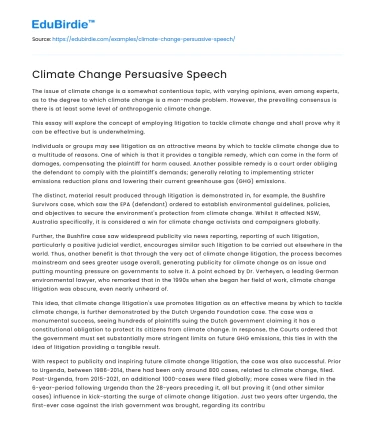The issue of climate change is a somewhat contentious topic, with varying opinions, even among experts, as to the degree to which climate change is a man-made problem. However, the prevailing consensus is there is at least some level of anthropogenic climate change.
This essay will explore the concept of employing litigation to tackle climate change and shall prove why it can be effective but is underwhelming.
Save your time!
We can take care of your essay
- Proper editing and formatting
- Free revision, title page, and bibliography
- Flexible prices and money-back guarantee
Individuals or groups may see litigation as an attractive means by which to tackle climate change due to a multitude of reasons. One of which is that it provides a tangible remedy, which can come in the form of damages, compensating the plaintiff for harm caused. Another possible remedy is a court order obliging the defendant to comply with the plaintiff's demands; generally relating to implementing stricter emissions reduction plans and lowering their current greenhouse gas (GHG) emissions.
The distinct, material result produced through litigation is demonstrated in, for example, the Bushfire Survivors case, which saw the EPA (defendant) ordered to establish environmental guidelines, policies, and objectives to secure the environment's protection from climate change. Whilst it affected NSW, Australia specifically, it is considered a win for climate change activists and campaigners globally.
Further, the Bushfire case saw widespread publicity via news reporting, reporting of such litigation, particularly a positive judicial verdict, encourages similar such litigation to be carried out elsewhere in the world. Thus, another benefit is that through the very act of climate change litigation, the process becomes mainstream and sees greater usage overall, generating publicity for climate change as an issue and putting mounting pressure on governments to solve it. A point echoed by Dr. Verheyen, a leading German environmental lawyer, who remarked that in the 1990s when she began her field of work, climate change litigation was obscure, even nearly unheard of.
This idea, that climate change litigation's use promotes litigation as an effective means by which to tackle climate change, is further demonstrated by the Dutch Urgenda Foundation case. The case was a monumental success, seeing hundreds of plaintiffs suing the Dutch government claiming it has a constitutional obligation to protect its citizens from climate change. In response, the Courts ordered that the government must set substantially more stringent limits on future GHG emissions, this ties in with the idea of litigation providing a tangible result.
With respect to publicity and inspiring future climate change litigation, the case was also successful. Prior to Urgenda, between 1986-2014, there had been only around 800 cases, related to climate change, filed. Post-Urgenda, from 2015-2021, an additional 1000-cases were filed globally; more cases were filed in the 6-year-period following Urgenda than the 28-years preceding it, all but proving it (and other similar cases) influence in kick-starting the surge of climate change litigation. Just two years after Urgenda, the first-ever case against the Irish government was brought, regarding its contributory role in failing to address climate change, whilst it ultimately failed it is indicative of Urgenda showcasing the possibility of suing one's government over its climate change shortcomings and prompting others to do so, as the Urgenda decision was explicitly mentioned within the case's judgment.
Across the globe, the Juliana (US) and Future Generations (Colombia) cases both saw youths suing their governments over matters regarding climate change, with Urgenda and similar cases hailed as an influence. Cesar Rodriguez, head of Dejusticia, the non-governmental organization responsible for the Colombian lawsuit, stated a court ordered the Netherlands' government to reduce its carbon emissions, we are asking that Colombia fulfills its prior commitments to tackle climate change. This clearly demonstrates the link between past and present cases; previous positive verdicts inspire new litigation action, a major benefit considering 'Raising awareness and exerting pressure' are considered primary motives for climate change litigation. This exertion of pressure compels companies, particularly those who have historically been majorly contributory to GHG emissions, such as those in the energy sector, to tackle their present impact and reduce their future effects (through setting emissions targets, phasing out fossil fuels, etc). Demonstrated in Milieudefensie, among others.
As has been demonstrated, climate change litigation where successful, amongst other benefits, has the effect of increasing the rate at which individuals and groups utilize courts in holding both public and private bodies to account for climate change, creating a positive feedback loop. What then happens when suits concerning climate change litigation fail?






 Stuck on your essay?
Stuck on your essay?

